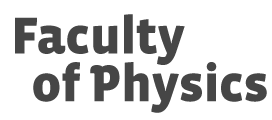Biological Physics and Bioinformatics Seminar
2014/2015 | 2015/2016 | 2017/2018 | 2018/2019 | 2019/2020 | 2020/2021 | 2021/2022 | 2022/2023 | 2023/2024 | 2024/2025 | Seminar homepage
2022-06-22 (Wednesday)
Prof. dr hab. Izabela Makałowska (Instytut Biologii i Ewolucji Człowieka, Wydział Biologii, Uniwersytet im. A. Mickiewicza, Poznań)
Does genes' retroposition have any purpose? Digging in the genomic recycling bin
https://zoom.us/j/91976153012?pwd=azNiMWE4UnhPN3lRQlY2UHZHOXVkQT09
Meeting ID: 919 7615 3012
Passcode: 747922
One tap mobile
+48223073488,,91976153012#,,,,*747922# Poland
+48223987356,,91976153012#,,,,*747922# Poland
Dial by your location
+48 22 307 3488 Poland
+48 22 398 7356 Poland
+48 22 306 5342 Poland
Join by Skype for Business
https://zoom.us/skype/91976153012
Bogdan Lesyng (UW)
Anna Niedźwiecka (IF PAN)
Piotr Zielenkiewicz (IBB)
Meeting ID: 919 7615 3012
Passcode: 747922
One tap mobile
+48223073488,,91976153012#,,,,*747922# Poland
+48223987356,,91976153012#,,,,*747922# Poland
Dial by your location
+48 22 307 3488 Poland
+48 22 398 7356 Poland
+48 22 306 5342 Poland
Join by Skype for Business
https://zoom.us/skype/91976153012
Bogdan Lesyng (UW)
Anna Niedźwiecka (IF PAN)
Piotr Zielenkiewicz (IBB)
2022-06-08 (Wednesday)
RNDr. Veronika Obšilová, Ph.D. (Institute of Physiology CAS, Laboratory of Structural Biology of Signaling Proteins, Vestec, Prague, Czech Republic)
Structural insight into the 14-3-3-dependent regulation of human Nedd4-2 ubiquitin ligase
https://zoom.us/j/91976153012?pwd=azNiMWE4UnhPN3lRQlY2UHZHOXVkQT09
Meeting ID: 919 7615 3012
Passcode: 747922
One tap mobile
+48223073488,,91976153012#,,,,*747922# Poland
+48223987356,,91976153012#,,,,*747922# Poland
Dial by your location
+48 22 307 3488 Poland
+48 22 398 7356 Poland
+48 22 306 5342 Poland
Join by Skype for Business
https://zoom.us/skype/91976153012
Bogdan Lesyng (UW)
Anna Niedźwiecka (IF PAN)
Piotr Zielenkiewicz (IBB)
Meeting ID: 919 7615 3012
Passcode: 747922
One tap mobile
+48223073488,,91976153012#,,,,*747922# Poland
+48223987356,,91976153012#,,,,*747922# Poland
Dial by your location
+48 22 307 3488 Poland
+48 22 398 7356 Poland
+48 22 306 5342 Poland
Join by Skype for Business
https://zoom.us/skype/91976153012
Bogdan Lesyng (UW)
Anna Niedźwiecka (IF PAN)
Piotr Zielenkiewicz (IBB)
2022-05-25 (Wednesday)
Dr Joanna Panecka-Hofman (Zakład Biofizyki, Wydział Fizyki UW, Warszawa)
The global and local dynamics of a homotetrameric folate pathway enzyme - pteridine reductase 1 - the target for anti-trypanosomatid drug design
https://zoom.us/j/91976153012?pwd=azNiMWE4UnhPN3lRQlY2UHZHOXVkQT09
Meeting ID: 919 7615 3012
Passcode: 747922
One tap mobile
+48223073488,,91976153012#,,,,*747922# Poland
+48223987356,,91976153012#,,,,*747922# Poland
Dial by your location
+48 22 307 3488 Poland
+48 22 398 7356 Poland
+48 22 306 5342 Poland
Join by Skype for Business
https://zoom.us/skype/91976153012
Bogdan Lesyng (UW)
Anna Niedźwiecka (IF PAN)
Piotr Zielenkiewicz (IBB)
ABSTRACT
Inhibiting the folate pathway of trypanosomatid parasites, which cause life-threatening human diseases such as leishmaniases, is a potentially useful drug design approach. Pteridine reductase 1 (PTR1) is a key trypanosomatid-specific enzyme of this pathway that needs to be targeted. The role of the PTR1 homotetramer local and global dynamics in its enzymatic function and inhibitor binding is poorly understood. Experimental data suggest that the PTR1 substrate and inhibitor binding may be regulated by the long-distance coupling between four binding sites in the homotetramer. Therefore, computational methods were applied to characterize the enzyme dynamical properties and its interactions with selected ligands. Normal mode analysis demonstrated correlated movements of substrate loops flanking the binding sites of the homotetrameric enzyme. Molecular dynamics study provided insights into the interactions of substrates, products and the model inhibitor with PTR1, and the potential mechanism of the, so-called, substrate inhibition phenomenon. Finally, a non-equilibrium method, Rotamerically Induced Perturbations, revealed flexibility hot-spots in the PTR1 homotetramer, and different levels of dynamical coupling between the particular PTR1 monomers.
Meeting ID: 919 7615 3012
Passcode: 747922
One tap mobile
+48223073488,,91976153012#,,,,*747922# Poland
+48223987356,,91976153012#,,,,*747922# Poland
Dial by your location
+48 22 307 3488 Poland
+48 22 398 7356 Poland
+48 22 306 5342 Poland
Join by Skype for Business
https://zoom.us/skype/91976153012
Bogdan Lesyng (UW)
Anna Niedźwiecka (IF PAN)
Piotr Zielenkiewicz (IBB)
ABSTRACT
Inhibiting the folate pathway of trypanosomatid parasites, which cause life-threatening human diseases such as leishmaniases, is a potentially useful drug design approach. Pteridine reductase 1 (PTR1) is a key trypanosomatid-specific enzyme of this pathway that needs to be targeted. The role of the PTR1 homotetramer local and global dynamics in its enzymatic function and inhibitor binding is poorly understood. Experimental data suggest that the PTR1 substrate and inhibitor binding may be regulated by the long-distance coupling between four binding sites in the homotetramer. Therefore, computational methods were applied to characterize the enzyme dynamical properties and its interactions with selected ligands. Normal mode analysis demonstrated correlated movements of substrate loops flanking the binding sites of the homotetrameric enzyme. Molecular dynamics study provided insights into the interactions of substrates, products and the model inhibitor with PTR1, and the potential mechanism of the, so-called, substrate inhibition phenomenon. Finally, a non-equilibrium method, Rotamerically Induced Perturbations, revealed flexibility hot-spots in the PTR1 homotetramer, and different levels of dynamical coupling between the particular PTR1 monomers.
2022-05-11 (Wednesday)
Dr hab. Piotr Setny (Centrum Nowych Technologii UW, Warszawa)
Granger causality analysis of protein beta-hairpin folding
https://zoom.us/j/91976153012?pwd=azNiMWE4UnhPN3lRQlY2UHZHOXVkQT09
Meeting ID: 919 7615 3012
Passcode: 747922
One tap mobile
+48223073488,,91976153012#,,,,*747922# Poland
+48223987356,,91976153012#,,,,*747922# Poland
Dial by your location
+48 22 307 3488 Poland
+48 22 398 7356 Poland
+48 22 306 5342 Poland
Join by Skype for Business
https://zoom.us/skype/91976153012
Bogdan Lesyng (UW)
Anna Niedźwiecka (IF PAN)
Piotr Zielenkiewicz (IBB)
ABSTRACT
Computer simulations allow capturing increasingly long fragments of molecular dynamics. Still, revealing functional relations or allosteric communication pathways that usually involve cascades of transient events is often difficult and calls for methodologies that depart from the well-grounded framework of equilibrium statistical physics. An approach towards the analysis of complex temporal signals is Granger causality analysis. It has found applications in the fields of neuroscience or econometrics and provides means to assess which components of multidimensional time series are most influential for the evolution of the entire system. Here, we apply Granger analysis to a long molecular dynamics trajectory depicting reversible folding of a mini beta-hairpin protein, CLN025. We find objective, quantitative evidence indicating that rearrangements within the hairpin turn region are determinant for its folding and unfolding. On the contrary, interactions between hairpin arms score low on the causality scale. Taken together these findings clearly favour the concept of zipper-like folding, which is one of two postulated beta-hairpin folding mechanisms. On a broader perspective, the results demonstrate the possibility of conclusive application of Granger causality analysis to a biomolecular system.
Meeting ID: 919 7615 3012
Passcode: 747922
One tap mobile
+48223073488,,91976153012#,,,,*747922# Poland
+48223987356,,91976153012#,,,,*747922# Poland
Dial by your location
+48 22 307 3488 Poland
+48 22 398 7356 Poland
+48 22 306 5342 Poland
Join by Skype for Business
https://zoom.us/skype/91976153012
Bogdan Lesyng (UW)
Anna Niedźwiecka (IF PAN)
Piotr Zielenkiewicz (IBB)
ABSTRACT
Computer simulations allow capturing increasingly long fragments of molecular dynamics. Still, revealing functional relations or allosteric communication pathways that usually involve cascades of transient events is often difficult and calls for methodologies that depart from the well-grounded framework of equilibrium statistical physics. An approach towards the analysis of complex temporal signals is Granger causality analysis. It has found applications in the fields of neuroscience or econometrics and provides means to assess which components of multidimensional time series are most influential for the evolution of the entire system. Here, we apply Granger analysis to a long molecular dynamics trajectory depicting reversible folding of a mini beta-hairpin protein, CLN025. We find objective, quantitative evidence indicating that rearrangements within the hairpin turn region are determinant for its folding and unfolding. On the contrary, interactions between hairpin arms score low on the causality scale. Taken together these findings clearly favour the concept of zipper-like folding, which is one of two postulated beta-hairpin folding mechanisms. On a broader perspective, the results demonstrate the possibility of conclusive application of Granger causality analysis to a biomolecular system.
2022-04-27 (Wednesday)
Prof. dr hab. Jarosław Stolarski (Instytut Paleobiologii PAN, Warszawa)
Going deep: coral biomineralization molecular toolbox along the depth gradient
https://zoom.us/j/91976153012?pwd=azNiMWE4UnhPN3lRQlY2UHZHOXVkQT09
Meeting ID: 919 7615 3012
Passcode: 747922
One tap mobile
+48223073488,,91976153012#,,,,*747922# Poland
+48223987356,,91976153012#,,,,*747922# Poland
Dial by your location
+48 22 307 3488 Poland
+48 22 398 7356 Poland
+48 22 306 5342 Poland
Join by Skype for Business
https://zoom.us/skype/91976153012
Bogdan Lesyng (UW)
Anna Niedźwiecka (IF PAN)
Piotr Zielenkiewicz (IBB)
Meeting ID: 919 7615 3012
Passcode: 747922
One tap mobile
+48223073488,,91976153012#,,,,*747922# Poland
+48223987356,,91976153012#,,,,*747922# Poland
Dial by your location
+48 22 307 3488 Poland
+48 22 398 7356 Poland
+48 22 306 5342 Poland
Join by Skype for Business
https://zoom.us/skype/91976153012
Bogdan Lesyng (UW)
Anna Niedźwiecka (IF PAN)
Piotr Zielenkiewicz (IBB)
2022-03-30 (Wednesday)
Prof. dr hab. Michał Dadlez (Instytut Biochemii i Biofizyki PAN)
Structural mass spectrometry helps to provide structures of difficult protein targets
https://zoom.us/j/91976153012?pwd=azNiMWE4UnhPN3lRQlY2UHZHOXVkQT09
Meeting ID: 919 7615 3012
Passcode: 747922
One tap mobile
+48223073488,,91976153012#,,,,*747922# Poland
+48223987356,,91976153012#,,,,*747922# Poland
Dial by your location
+48 22 307 3488 Poland
+48 22 398 7356 Poland
+48 22 306 5342 Poland
Join by Skype for Business
https://zoom.us/skype/91976153012
Meeting ID: 919 7615 3012
Passcode: 747922
One tap mobile
+48223073488,,91976153012#,,,,*747922# Poland
+48223987356,,91976153012#,,,,*747922# Poland
Dial by your location
+48 22 307 3488 Poland
+48 22 398 7356 Poland
+48 22 306 5342 Poland
Join by Skype for Business
https://zoom.us/skype/91976153012
2022-03-16 (Wednesday)
Dr. Tomasz Zajkowski (Research Scientist at NASA Ames Research Center)
An Evolutionary Perspective on Prion-Based Mechanisms of Regulation and Adaptation
!!! NEW ZOOM LINK !!!
https://zoom.us/j/91976153012?pwd=azNiMWE4UnhPN3lRQlY2UHZHOXVkQT09
https://zoom.us/j/91976153012?pwd=azNiMWE4UnhPN3lRQlY2UHZHOXVkQT09
2022-03-02 (Wednesday)
Prof. dr hab. Wiesław Gruszecki (Maria Curie-Skłodowska Uniwersity, Lublin)
Why and what for is the yellow spot in your eye yellow
2022-01-26 (Wednesday)
Dr. Marta Pilz (Institute of Physical Chemistry, PAS)
Advanced fluorescence-based methods to study drug delivery
https://us06web.zoom.us/j/86164434048
Medical application of nanotechnology and nanomedicine is a broad field of research describing the use of nanomaterials to combat a number of diseases, including cancers. Despite the variety of approaches available, there is still a lack of strategies offering quantitative analysis to assess the suitability of new compounds or nanoparticles as potential therapeutic agents. The key issue is therefore to establish appropriate models and tools that could be applied in preclinical research to assess the advances made in nanomedicine. To address this need, I focus my research on developing new fluorescence-based methods for studying the transport of drugs: in tissues, through the cell membrane and inside the cell. The devised methodologies allow to measure the mobility of any fluorescent molecule in the extracellular spaces of tumour models, the cellular uptake kinetics of drugs or drug carriers, and characterize drug-target interactions.
2021-12-15 (Wednesday)
Dr. Szymon Nowakowski (Center for Machine Learning, IDUB project, Faculty of Physics, University of Warsaw)
Protein folding using machine learning - structure and functionality of the AlphaFold service
https://us06web.zoom.us/j/86164434048
It seems that the half-century problem of protein folding has finally been largely solved. This latest breakthrough was achieved not only by gaining in-depth insight into the mechanics of protein folding, but by the very skilful use of black-box machine learning methods. This has been achieved not in academia, but in a private sector enterprise. In this seminar, due to the limited time available, I will describe the basics of the Alphafold model, leaving aside possible future surprises and consequences. Time will tell how far they can go.
2021-11-24 (Wednesday)
Dr Mateusz Kogut (IFPAN)
From full-atom simulations of non-canonical DNA to coarse-grained models predicting protein structures
2021-10-27 (Wednesday)
mgr Barbara Klepka (IFPAN)
Studies of hydrodynamic properties of coral acid-rich proteins by means of fluorescence correlation spectroscopy
2021-10-13 (Wednesday)
Dr.Joanna Bojarska (Politechnika Lodzka)
Short peptides: towards smart terapies
2021-10-06 (Wednesday)
Dr. Kaja Moczulska (Francis Crick Institute, previously at Svante Pääbo Lab, Leipzig)







